Best Trolling Motor Battery [2023]
Table of Contents
- Best Trolling Motor Battery [2023]
- These Are The Best Trolling Motor Battery In 2023:
- Universal Power Group 12V 100Ah Solar Wind AGM SLA DEEP Cycle VRLA Battery 12V 24V 48V
- Optima OPT8016-103 Batteries D34M BlueTop Starting and Deep Cycle Marine Battery
- Mighty Max Battery ML55-12 SLA Trolling Motor Battery
- Weize 12V 35AH SLA AGM Deep Cycle Marine Trolling Motor Battery
- Minn Kota 1820175 Trolling Motor
- How to Choose the Best Trolling Motor Battery Buyers Guide
- Best Trolling Motor Battery Types
- Best Trolling Motor Battery Tips
- Best Trolling Motor Battery FAQ
Trolling motors are used equipment for powering fishing trips due to their simplicity and cost effectiveness. They offer lasting operation on a charge making them ideal when the boats engine is undergoing repairs or being stored.
Whats more there is a variety of trolling motors each with its own strengths and weaknesses in terms of performance. Understanding these differences will enable fishermen to make informed decisions when choosing the motor that best suits their needs.
In this article we will discuss some of the used trolling motors and highlight their advantages and disadvantages. This will help you select the trolling motor battery for your fishing adventures in 2023.
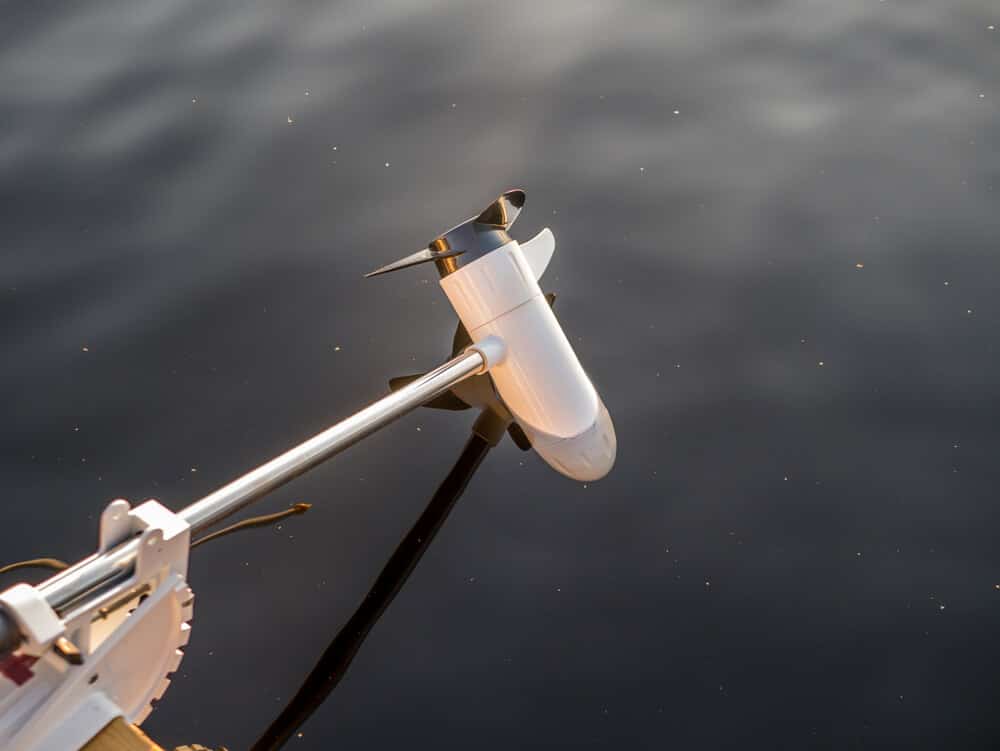
These Are The Best Trolling Motor Battery In 2023:
Universal Power Group 12V 100Ah Solar Wind AGM SLA DEEP Cycle VRLA Battery 12V 24V 48V
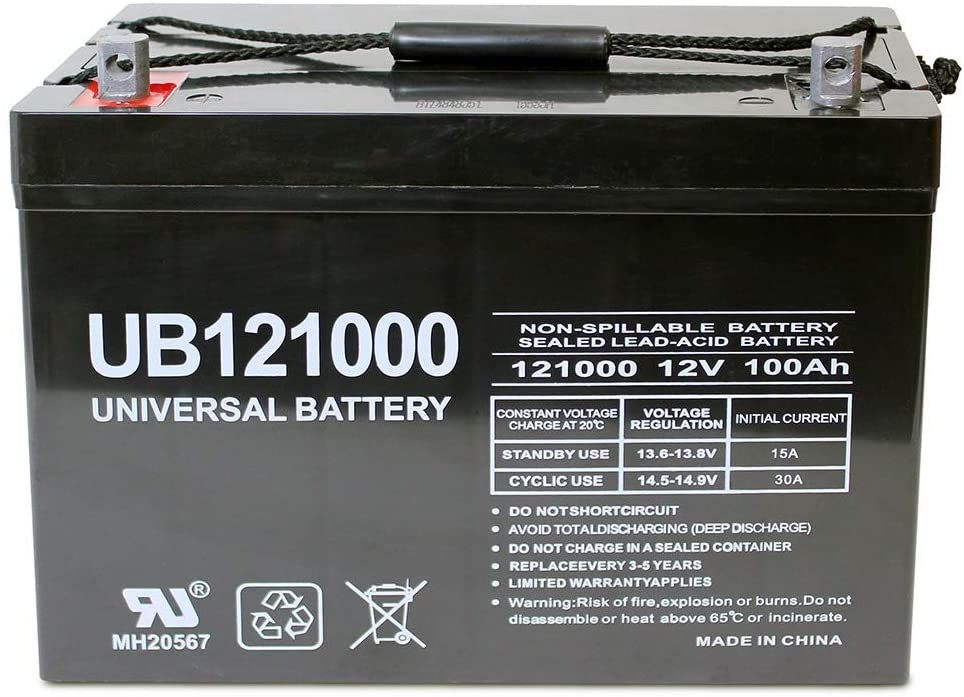
If you’re searching for a battery that seamlessly integrates with your fishing gear look no further, than the Universal Power Group 12V 100Ah Solar Wind AGM SLA DEEP Cycle VRLA Battery. With its durability and high power output this battery is specifically designed for electric trolling motors in ponds, lakes or rivers.
The benefits of this product are evident; it boasts durability and power. Many battery owners consider it their “primary equipment” or even “the best battery they’ve ever owned ” thanks, to its lasting performance. Overall it’s a battery option especially considering its price.
While there are some drawbacks they can be easily addressed. The connecting cable is quite short. May not reach distances. Additionally the lack of a shield leaves it susceptible to short circuits if mishandled. Moreover the mounting hardware is a bit flimsy which can pose a challenge during installation.
In spite of these flaws the Universal Power Group 12V 100Ah Solar Wind AGM SLA DEEP Cycle VRLA Battery 12V 24V 48V remains a product considering when searching for batteries for your favorite equipment. This is particularly true if you’re on a budget but still desire lasting performance.
Optima OPT8016-103 Batteries D34M BlueTop Starting and Deep Cycle Marine Battery
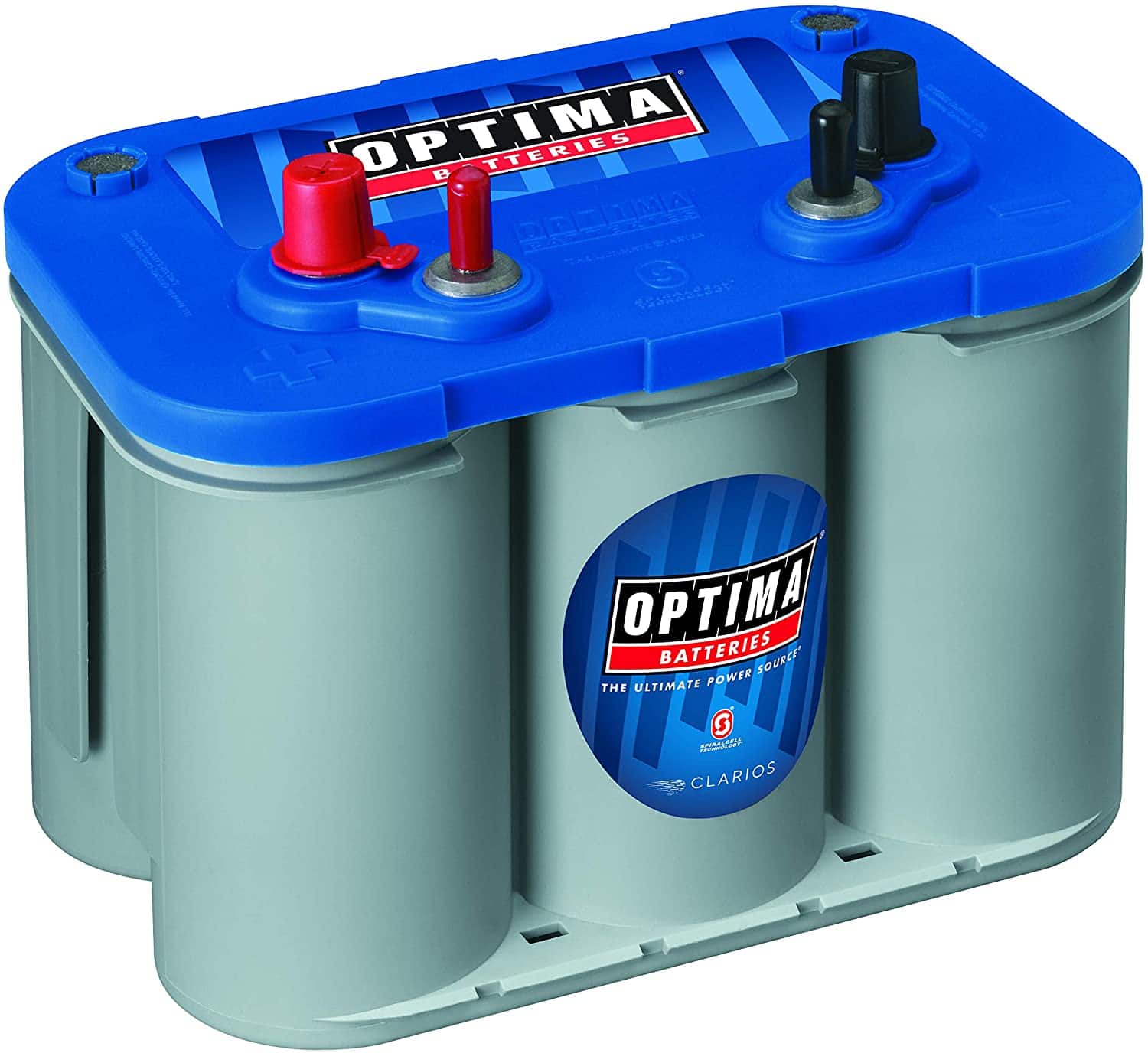
Another notable battery option is the OPT8016 103 from Optima Battery Company—an expert in manufacturing both cycle and starting batteries. Specifically speaking about their BlueTop Starting and Deep Cycle Marine Battery model it’s a six volt battery, with an eight amp hour capacity.
This BlueTop Starting and Deep Cycle Marine Battery stands out for its starting and deep cycle capabilities, which can be attributed to the presence of two types of plates, within the battery. It’s worth noting that this battery follows the AGM (Absorbed Glass Mat) design.
One notable advantage of this battery is its versatility in installation as it can be placed in any position. This makes it particularly well suited for use on boats. Additionally the top post terminals make assembly easier. Another convenient feature is the built in charging system.
The OPT8016 103 battery excels at handling high discharge loads without sustaining damage. With a lifespan of 3 to 4 years it proves to be a choice. This battery finds application in emergency lighting GPS devices and bass fishing systems. It boasts a shelf life of 2 years or more.
It’s important to highlight that this battery has undergone testing by the manufacturer in accordance with UL Standard 422 and UN Transportation Specification (UN 38.3). The plates are composed of a high quality lead calcium alloy that ensures power delivery in temperatures as low as 5 degrees Celsius.
Pros
The OPT8016 103 battery offers usage in any position.
assembly with top post terminals.
Sealed lead acid design, with built in smart charging system.
Environmentally friendly and fully recyclable.
Cons
None mentioned in the text.
The OPT8016 103 Battery should be monitored to prevent overcharging as it can lead to damage. It is advisable to charge the battery when its voltage drops below 12 volts.
Mighty Max Battery ML55-12 SLA Trolling Motor Battery
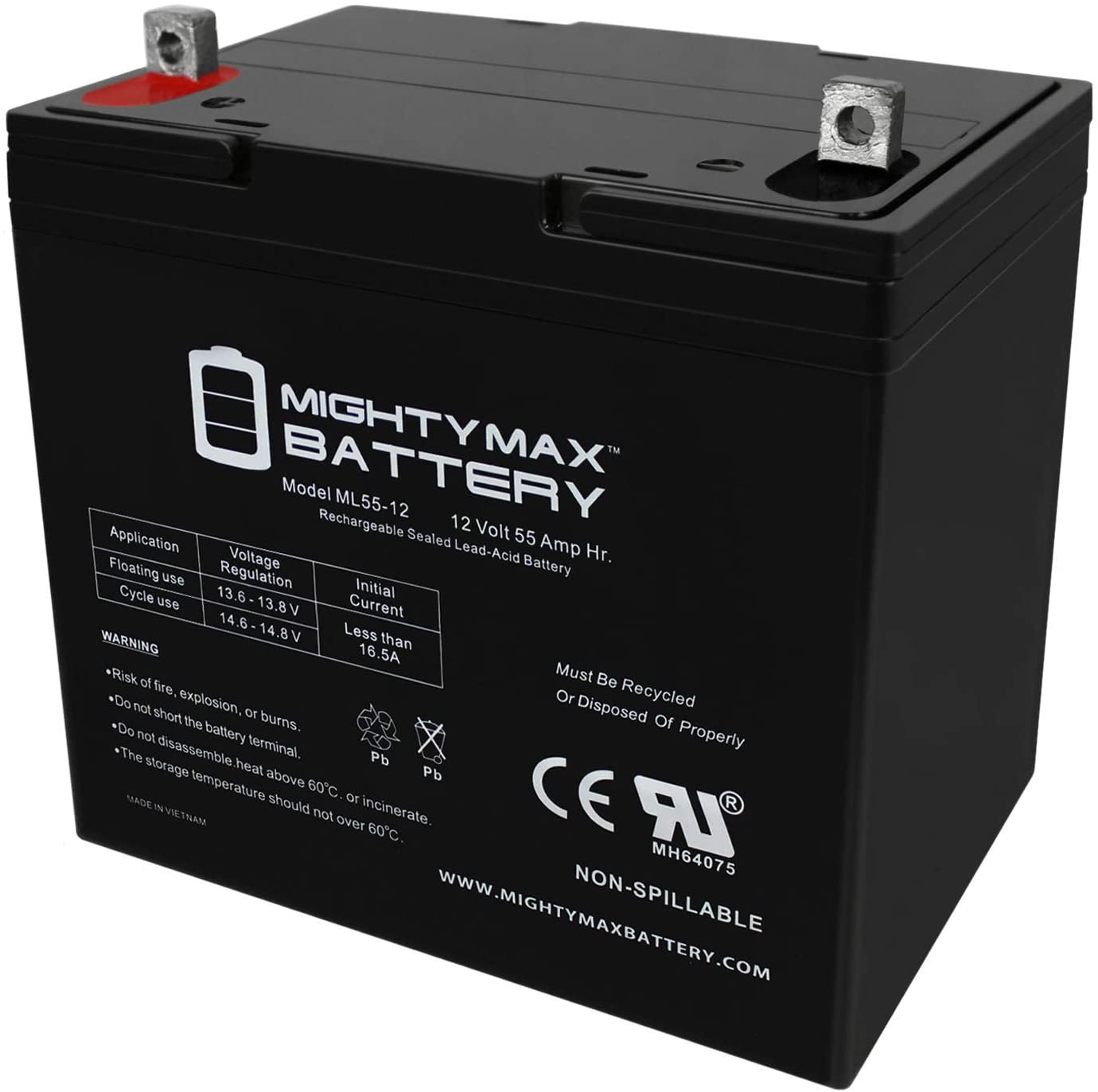
One notable battery option, for trolling motors is the Mighty Max Battery ML55 12. It is a 12 volt battery specifically designed for boats that require power. Compared to batteries with capacities of 100 or 120 amp hours this battery has a capacity of 36 amp hours.
The ML55 12 offers advantages, including its cost making it an attractive choice for consumers looking to save money on their boats battery purchase. Additionally using this battery contributes to friendliness due to its reduced lead usage compared to capacity batteries like 24 volt ones or other lead acid batteries commonly used in trolling motors. Moreover when not, in use the ML55 12s smaller capacity allows it to last longer since it has storage time. For instance the control circuit activates for a duration. Drains the battery less frequently.
Furthermore the ML55 12 features a design that easily fits into motors.
The ML55 12 battery offers two mounting options; it can be mounted flat, against the motor. Positioned in a gravity manner when used alongside another 12 volt trolling motor battery called the ML55 22. This dual mounting system is a feature of this battery. While the ML55 12 has a capacity of 72 amp hours its counterpart, the ML55 22 has a capacity of 72 amp hours. The ML55 22 is best suited for boats that require power from their trolling motor while the ML55 12 with its smaller capacity is ideal for smaller boats.
Pros
This battery is cost effective.
It has a capacity compared to powerful batteries.
Being environmentally friendly it is made from lead acid. Poses no harm to the environment if disposed of correctly.
The dual mounting system of this trolling motor battery ensures stability for the trolling motor.
Cons
While you can mount the ML55 12 in a mounting system with another 12 volt trolling motor battery it cannot be mounted alone.
The durability of the trolling motor brush used in conjunction with the ML55 12 is not as high as that available, for model trolling motor batteries.Product Review; Weize 12V 35AH SLA AGM Deep Cycle Marine Trolling Motor Battery
Weize 12V 35AH SLA AGM Deep Cycle Marine Trolling Motor Battery
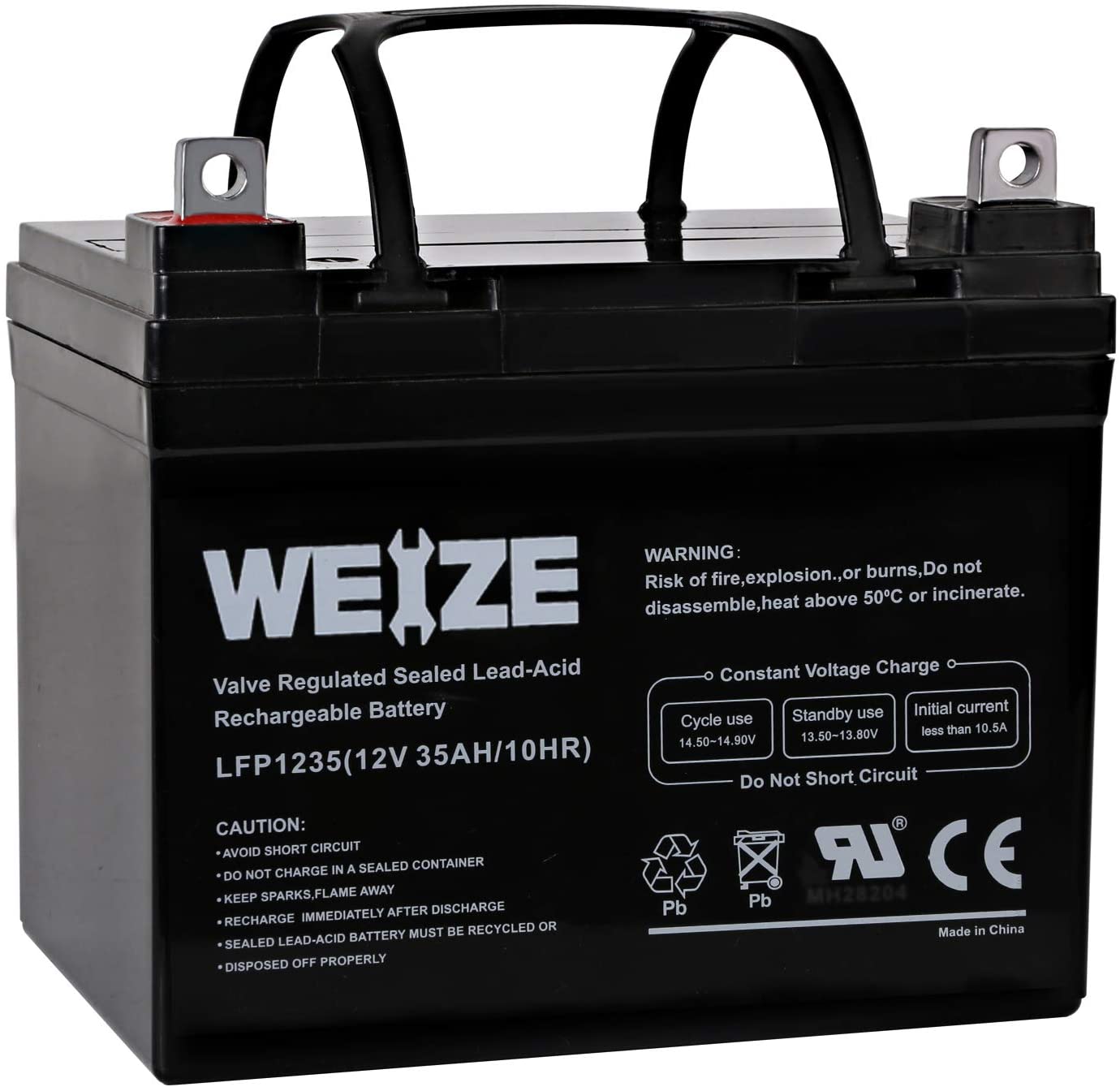
The Weize 12V 35AH SLA AGM Deep Cycle Marine Trolling Motor Battery is a top notch option, for boat owners seeking an durable battery. With its 12V voltage and reasonable price it serves as a replacement or upgrade choice. Designed specifically for longevity this battery is ideal for activities and off road recreational vehicles. Notable features include;
1. Lifespan; This battery is built to last ensuring that you receive lasting performance and value for your money.
2. Overcharge protection; The battery includes built in safeguards against overcharging, which can permanently drain its energy and shorten its lifespan. With this feature you can use the battery worry free while ensuring safety.
Overall the Weize 12V 35AH SLA AGM Deep Cycle Marine Trolling Motor Battery stands out as a choice that provides both durability and performance, for your boating needs.
The marine battery is equipped with a built in safeguard, against overcharging, which can lead to energy drainage and a shortened lifespan. This feature ensures the battery remains safe and protected from any damage. Additionally it includes a charge control system that maintains its quality and performance while offering options from China.
Advantages
Extended durability; This battery is designed to withstand the test of time providing lasting and effective functionality that guarantees your investment.
Protection against drainage and float charge; With its built in overcharge protection, the marine battery safeguards against energy depletion caused by charging. You can use it with peace of mind knowing that any potential damage is mitigated.
The marine battery incorporates a mechanism to prevent overcharging, which could permanently drain its energy and result in battery failure. It offers a level of safety allowing worry usage. Additionally it features a charge control system, for operation.
The batteries offered by this company provide quality at a price ensuring that their performance and standards are maintained.
Cons
Please note that these batteries are not suitable, for temperatures. They are not designed for winter use. Are best suited for climates. If you plan to use the battery in a low temperature environment it is important to keep it at room temperature before usage to prevent any damage. This precaution will ensure hassle damage free usage for your boat or boat accessories.
Minn Kota 1820175 Trolling Motor
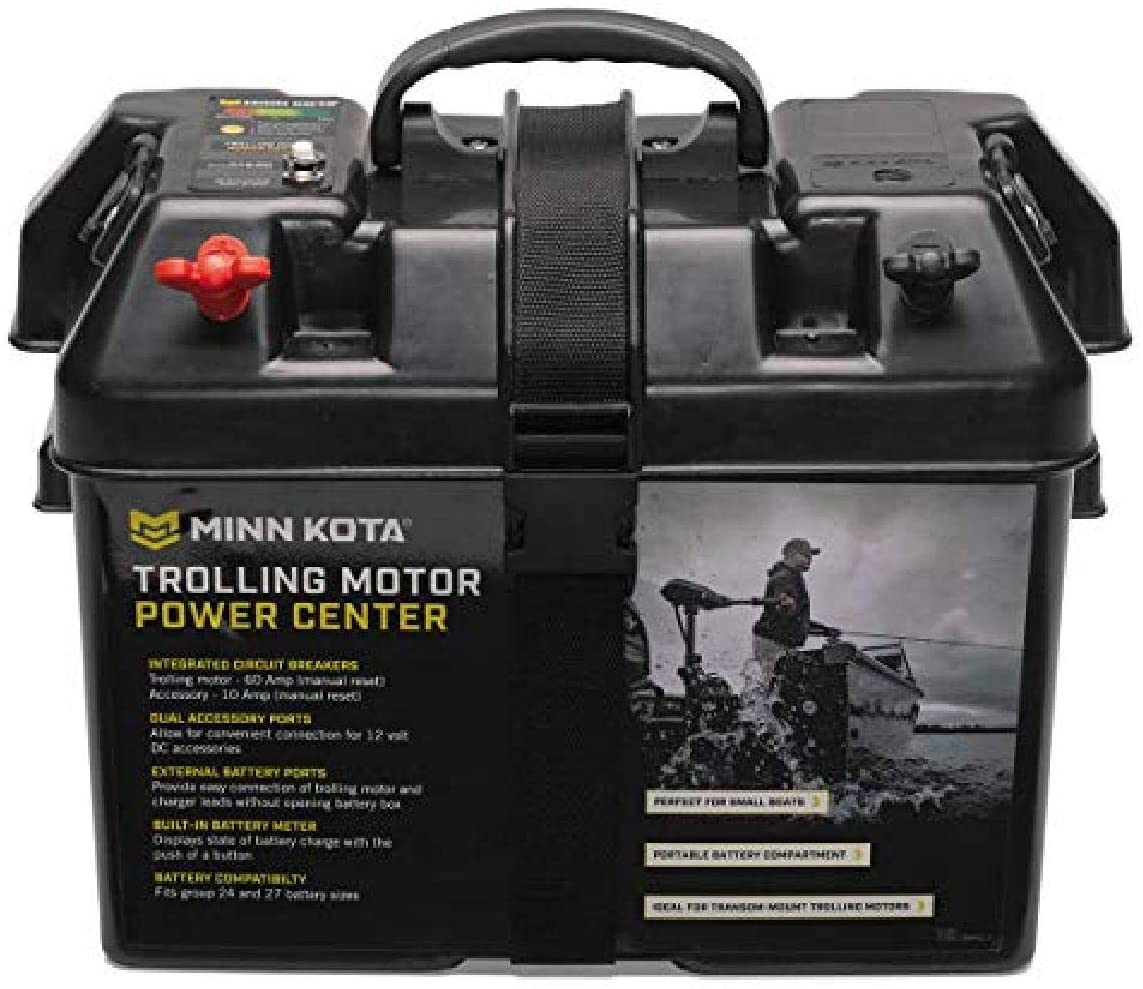
When considering purchasing a motor battery for your boat many options are available on the market today. One popular choice is the Minn Kota 1820175 Trolling Motor Battery—a 12 volt deep cycle battery commonly used with trolling motors. However selecting the battery, for your specific needs might be confusing.
This article aims to provide you with an analysis of both the advantages and disadvantages associated with types of batteries. By assessing these pros and cons you’ll be able to make a decision regarding which battery best suits your boats requirements.
The product review, for the Minn Kota 1820175 Trolling Motor Battery goes as follows; It is a trolling motor battery but it offers some additional features that make me lean towards recommending it over others like the Minn Kota 182019.
Advantages
One great feature is its timing lock function, which makes adjusting start times for both trolling motors and regular engine motors much easier. With a 10 second button press you can choose to lock the batteries in their settings or adjust them on the go.
It also comes with a sealed dual purpose protection circuit that completely isolates the battery from your boat while providing resistance to vibrations and impacts.
You can also use a float switch” with this battery, which shuts down the batteries once they reach a level. This comes in handy when you need time for your engine to warm up after starting it. The batteries will stay powered and locked in their settings until you unlock them with another 10 second press of the button.
Similar, to motor batteries the Minn Kota 1820175 has built in connectors and dual purpose terminals for positive and negative connections making installation a breeze.You don’t have to go through the hassle of searching, buying or installing terminals to connect the battery to your system.
Cons
One drawback of the Minn Kota 1820175 similar, to motor batteries is its slightly higher price. However when you consider its features that are not commonly found in trolling motor batteries it can be seen as a worthwhile investment.
To summarize the Minn Kota 1820175 is a high quality trolling motor battery that justifies its premium price tag.
How to Choose the Best Trolling Motor Battery Buyers Guide
When selecting a motor battery there are three factors to consider; durability, peak power draw and maintenance. These specifications play a role, in ensuring that you acquire a motor that performs well and has a long lifespan. Additionally it is essential to choose the voltage, for your boat and understand the significance of having power output.
One significant aspect to keep in mind is the durability of the trolling motor battery. It should be able to withstand speeds and heavy loads without weakening or faltering over time.These components can often be put under a lot of strain. It’s advisable to look for one that is designed to handle power demands and is resistant, to vibrations. This ensures that the batteries can endure conditions and remain durable enough to last through fishing trips without malfunctioning prematurely.
Peak Power Draw refers to the amount of current (measured in amps) used by the trolling motor. It’s crucial to select a battery with power output because if this value is too low the motor will only be able to maintain a speed and may eventually shut down during prolonged use. On the hand a battery with draw can lead to difficulties when attempting high speed turns due to insufficient torque.
Maintenance plays a role in choosing motor batteries as they can be sensitive to issues such, as over discharge or faulty charging systems. It is essential to use a charger that matches the specifications of the battery and regularly inspect for signs of failure or sulfur buildup which should be promptly cleaned from ports and terminals. Experts strongly advise against leaving a battery in a discharged state for periods of time.Weight; On average trolling motor batteries typically weigh, between 6 and 12 pounds. So if you want to carry it around it’s crucial to find one with a design. Smaller batteries that are well balanced can be conveniently carried by the operator whereas larger models might require lifting tackle or other equipment to lift and handle.
Run Time; Run time refers to the duration until the battery needs recharging. Generally run times are preferred because they tend to last. However it’s important to consider power draw when making a decision. Smaller batteries are commonly used on boats. Have shorter run times compared to larger batteries that are often suitable for larger watercraft.
Lifespan; Lifespan indicates the number of cycles. Recharges a battery can endure before its performance starts deteriorating. Larger batteries usually have lifespans than ones but this doesn’t mean that size should be completely ignored. It’s essential to choose a battery that can last a time without experiencing excessive deterioration or damage due, to misuse.
Vibration Resistance; When selecting a motor battery it’s important to consider its vibration resistance as it directly affects its longevity.
It is advisable to place batteries in cases or dedicated holders to prevent any damage. If possible avoid storing batteries in areas where they are directly exposed to wind and waves as this can cause them to shake and endure impact.
The size of the battery is a factor as it determines its dimensions and can significantly impact the weight of the boat. Larger boats typically require batteries, which tend to be heavier. Therefore when selecting a motor battery it is crucial to consider finding a balance, between size and weight. This ensures that you have equipment that lasts longer without becoming too burdensome for the operator.
Recharging is essential, for every motor battery. There are several available methods. You can use battery chargers that plug into outlets install panels on your boat for direct battery recharging or opt for portable rechargers that you can take with you wherever you go. It’s important to select a charging method that fits your budget and works effectively in your setup.
Electric trolling motors operate by utilizing a generator to power a propeller assembly consisting of blades. These motors generate thrust by using electricity stored in batteries to rotate the propeller.
This technique is commonly employed when fishing in waters using moving boats and is also popular, as a source of entertainment while engaging in activities like waterskiing or tubing behind a boat.
These motors come equipped with individual control panels that allow for the propeller to rotate at speeds while enabling levels of thrust to be generated. They can be tilted upwards or downwards to control the position of the propeller assembly and steer the boat accordingly. More recent models have adopted power eliminating the need for onboard power storage. This makes them significantly lighter and easier to maneuver compared to trolling motor batteries.
Step Up/Down Converters
Step up converters are used to convert voltage (12V) into voltage (120V) whereas step down converters serve the purpose of converting high voltage (120V) into low voltage (12V). These converters are essential, for applications where AC current’s not readily available. It’s advisable to keep a converter handy as most solar panels come with one that may require replacement if damaged. In case of damage the converter can be replaced with either the type or its opposite counterpart.
A single converter that can either step up or step down the voltage can be utilized in two ways. For example you can use a 12 volt converter to step up the voltage or a 220 volt converter to step it down.
Best Trolling Motor Battery Types
Different Types of Trolling Motor Batteries
If you’re searching for the trolling motor battery that can withstand challenging terrains and extreme conditions there are types available. However it’s crucial to choose the type based on your requirements. This article will outline some of the types of motor batteries including;
1. Marine Trolling Motor Battery; Designed with heavy duty plates marine batteries offer performance, in conditions and varying temperatures.
2. Deep Cycle Trolling Motor Battery; Featuring plates of being fully discharged and recharged deep cycle batteries have porous material that absorbs energy as liquid acid electrolyte. These batteries perform well during high discharge cycles. Extended periods of infrequent use.
3. Dual Purpose Trolling Motor Battery; Combining features, from both cycle and marine batteries, dual purpose batteries possess plates compared to deep cycle ones while also being easier to recharge than marine batteries.
This type of battery is commonly recommended for vehicles, like cars and boats.
The Car or Starting Trolling Motor Battery; A starting or car battery is less powerful and specifically designed to provide power until a car engine starts. It has a weight capacity. Tends to last longer when used regularly over several years.
Internal Composition of Trolling Motor Battery; The internal composition of a motor battery can vary depending on the type. Most batteries have negative sides that connect with the battery terminals of your motor.
The Lead Acid Wet Cell Trolling Motor Battery; The wet cell is a type of battery that has been replaced by technology. It consists of lead acid cells connected in series along with plates inside the battery case that form the electrolyte. These plates are made up of oxide which’s an electrochemical material used in traditional wet cell batteries.
AGM Trolling Motor Battery; AGM batteries are sealed by being encapsulated in a material making them resistant, to water and capable of being stored outdoors without any risk of damage. The electrolyte is suspended in a gel, which prevents any acid from spilling out.
Best Trolling Motor Battery Tips
it’s important to understand that the size of a battery doesn’t determine its output or capacity. When it comes to deep cycle batteries, their power and energy capability are measured in hours (Ah) not dimensions. For instance a battery with an Ah rating of 100 can provide much power as one rated at 50 Ah. Typically deep cycle lead acid batteries for boats have an Ah rating ranging from 80 to 100.
To determine the ampere requirement for your boats systems consider the amp draw from the engine alternator. To calculate the amp/hour rating of your battery accurately subtract 10% from the number displayed on its label. For example if you read 100 amps on your battery label deducting 10% (which’s equivalent, to 40 amps) and dividing that number by 2 will give you an estimate of how Ahs you should aim for to ensure sufficient power throughout the day.
Assuming you’re using high quality batteries, like Kirkland lithium batteries or the ones I use in my boat and truck here are some tips for maintaining your trolling motor battery;
Regular maintenance involves changing the electrolytes every month or so and adding water when necessary. Make sure to change them at a month especially during hot weather and in saltwater conditions. Don’t forget to clean and inspect the battery terminals for any corrosion. Of using a wire brush on the battery posts it’s better to use a cloth to wipe any corrosion or protective coating.
When it comes to charging maintenance always remember to turn off the charger before removing the battery from your boat or RV. Avoid overcharging your batteries as it can be detrimental. It’s generally a practice to disconnect your batteries after each use and store them separately when not being charged. This helps extend their lifespan while allowing for rotation between them.
Here are some additional tips for maintaining motor batteries; If a battery remains unused for, than six months make sure to check its water levels monthly and add water if needed to prevent sulfation.
If you have a number of batteries stored make sure to mark the date of the usage directly on each battery using a permanent marker. This way you can easily keep track of when maintenance’s needed. To determine if your battery requires water, a simple and inexpensive hydrometer can be used. Just check if it floats in the electrolyte and take note of the reading. If month the hydrometer shows than 1.25 volts it’s likely that your battery needs water. Otherwise you can let them sit until spring. Remember that a little maintenance goes a way.
Optimizing Trolling Motor Battery Run Time
When operating your boats motor or motor controller it’s crucial to select the battery settings for your specific application in order to maximize run time. Most trolling motor controllers offer a dual battery configuration option that automatically shuts down if both batteries reach levels of charge. Before enabling automatic shut down ensure that you set the controllers output to its setting so as to extend each batterys time as much, as possible. If you are using two batteries in parallel and intend to utilize them at performance (without any load) then set your controllers setting between 20 and 30 amps, per battery in order to prolong their lifespan.
Choosing the Right Battery, for Your Trolling Motor
When it comes to selecting a motor system there are options and brands available. The quality of your motor depends on factors; the type of motor (outboard, inboard, stern drive) the desired size (such as foot control or helm) and the type of boat you have. The first thing to consider is whether you intend to use a heavy lift propeller or not. For boats using a heavy lift propeller at speeds while charging the batteries for extended periods like during a weekend outing can boost power significantly. Alternatively you can opt for a propeller. Charge the batteries daily over a weekend.
Trolling Motor Battery and Setup
To properly calibrate your motor it’s important to know the exact amperage load that your motor will draw. This information will help you set the current on your motor controller to achieve the desired power output. The best way to determine this is by ensuring that your battery is fully charged and then connecting either a fish finder, with data display or a digital panel ammeter directly to your battery terminals.
Now go ahead. Activate the trolling motor and retract the boats anchor (or operate the boats windlass).
Best Trolling Motor Battery FAQ
Q; How can I charge these batteries while on the lake?
A; The convenient method is to connect the trolling motor battery charger to your boats cigarette lighter outlet and let it charge while you’re out, on the water. However please keep in mind that this charging method may not be as effective due to amperage caused by engine noise and vibration. If possible it’s best to find a location with shore power and plug it into a socket. Alternatively consider taking your boat to a marina where there is shore power available. It is highly recommended to keep your motor battery charged while on the water, for longevity.
Q; How long will a 12v battery run a motor?
A; There are two types of batteries commonly used for trolling motors. Flooded and deep cycle batteries. Flooded batteries contain acid. Are designed to withstand being submerged in liquid while deep cycle batteries do not contain any acid. To charge these types of batteries you’ll need a charger rated at 50 amps. However if your trolling motor operates on 4 J or 6 J power you can use a trickle charger.
Q; How do I wire a motor to the batteries?If you have a dual battery system and your trolling motor is connected to one of them simply attach the clip of the wire to the terminal and connect the black clip to the negative terminal. In case you’re using a battery system detach your ground wire and connect it to both terminals. To prevent corrosion you can use a silicone spray. Apply a protection product, like NoCorrode on both terminals before connecting them.
Can I use a car battery for my motor? No car batteries are specifically designed for use.
How long will these batteries last? On average a 12 volt battery lasts around four years while a 24 volt battery lasts seven years. Generally speaking they should last around 12 years before requiring replacement. However this duration can vary depending on how you maintain and charge your batteries or if they are stored for periods of time. Storing batteries, for long will gradually decrease their performance level. Weaken their strength over time.
Do you have to charge your trolling motor battery every month? The frequency of charging depends on your usage. How well you maintain it. If the battery remains inactive, for a period without recharging it may lose its effectiveness. Discharge faster. Similarly prolonged exposure to sunlight can also diminish its effectiveness. However if you use a trickle charger (although not recommended) the battery won’t discharge quickly. Generally it is advisable to charge your battery every three months. This can vary depending on how you handle and store it in order to maximize its lifespan.
How frequently should I charge my trolling motor battery? It primarily depends on the size of your motor and how often you use it. For motors charging twice a week should suffice, while for larger motors with greater power output weekly charging is adequate. In the case of trolling motors that take longer to charge and discharge (depending on what you’re charging) it is recommended to recharge them every three months.
What is the effective method, for charging this type of battery?To properly charge your marine battery it is recommended to use a 50 amp marine battery charger of a trickle charger. You can conveniently do this either at your house or, in the garage. It’s important to allow the battery to charge fully before putting it into use. Additionally it’s advisable to check your battery especially if it remains unused for a period of time as its performance may decline over time. By taking care of your boats equipment and ensuring they are adequately charged you can extend the lifespan of your battery.
The rate at which a deep cycle battery discharges depends on its usage. If the battery remains connected to a 12 volt system for a period, without being hooked up to an alternator it will discharge rapidly. Follow the instructions provided with your charger. Recharge the battery approximately every three months. If you’re not using the battery all allow it to fully discharge until there is no remaining charge.
The duration for which a deep cycle battery retains its charge relies on how you maintain it. If you aren’t using the battery it should hold its charge for three months.
If you use the battery frequently it should last for two weeks. Typically this type of battery has a lifespan of, around four years although this duration can vary based on how you handle and care for them.
When it comes to disposing of a deep cycle marine battery you cannot simply throw them in the garbage due to their acid content. Before discarding them make sure they are completely drained and remove all the caps.
Why are deep cycle batteries considered ideal for trolling motors? Well these batteries are specifically designed to handle repeated discharges of their capacity. When the engine is not running a trolling motor draws an amount of current from the battery to power electronics like lights and sonar units. This continues until the battery is almost depleted ( leaving 10% charge). At that point it switches to “float mode,” which uses current while maintaining voltage to prevent that bit from draining completely as it recharges.
What is the typical amperage drawn by trolling motors? On average trolling motors draw, between 3 and 7 amps.
How long can a trolling motor operate on a deep cycle battery?
Its not recommended to use discharged batteries for periods, such, as long fishing trips. If the motor stops you won’t be able to start it until the battery recharges. Therefore you’ll need to bring the boat to land and recharge the battery. If you let the battery run low it’ll be difficult to get it started again.
What type of charger should I use for AGM motor batteries?
The ideal charger is a charging system. These systems are designed to charge your trolling motor battery precisely as it requires. Won’t overcharge it like some chargers might do. They work well with both AGM batteries and wet cell batteries.
How significant is a Battery Warranty?
Most batteries come with a warranty, around 1 year. While there are warranties they usually don’t apply to trolling motor batteries. These batteries can endure at twice much abuse as regular 12 Volt car or truck batteries. They require maintenance and water testing compared to regular car or truck batteries. If your battery has a warranty of, than 1 year you might want to consider getting a lasting battery with an extended warranty.
How can I determine the group size of my batteries?
Typically most batteries have markings, on their bottom indicating their type, such as AGM or GEL. These acronyms stand for “Absorbed Glass Mat”. Gelled electrolyte,” which refer to the electrolyte used in each battery. Additionally batteries are assigned a number or code consisting of 3 or 4 digits, including letters. The first letter in this code indicates the batterys size. If you have a battery simply check its code. If it matches you’re looking at the correct group size. It is crucial to match both batteries in a set to ensure performance and cycle life.
Is it worthwhile to invest in AGM batteries of Wet Cell ones?
Absolutely! AGM batteries utilize glass mats to contain acid within them. These mats differ from lead acid batteries as they are crafted from a blend of glass that offers resistance against breakage.
What options do I have when it comes to selecting battery types?
The market today offers variants of AGM Batteries, some, with warranty periods compared to others.
The Wet Cell is the used AGM battery type and it offers a 1 year warranty, along with excellent cycling capability. However it falls short when it comes to long term storage compared to AGM batteries, with levels of wet or absorbed electrolytes.


